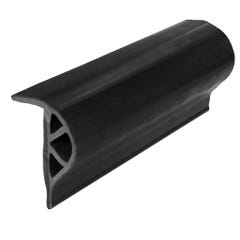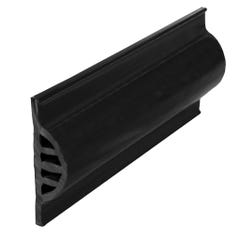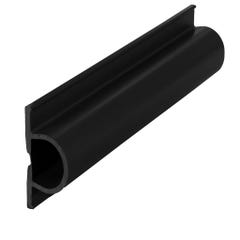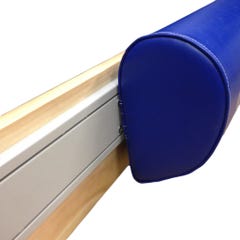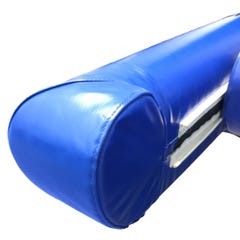What to Know When Buying Dock Bumpers
November 28, 2022 7 min read


Here’s a secret: you’re not the only boater who bumps the dock on occasion. All of us do — even the pros. In fact, skilled boaters sometimes deliberately use the dock for leverage in challenging situations in a technique called “springing” that involves keeping one or more lines tied to the dock while using forward or reverse power to maneuver the boat.
That’s why dock bumpers (also known as dock edging and dock fenders) come in so many different shapes, materials, and sizes. Despite our best efforts to use boat fenders to prevent it, an unprotected dock — whether it’s wood, aluminum, concrete, or another material — can inflict real damage on a boat hull. And, although we don’t think about it as much, boat-to-dock contact can also damage docks over time.
Contents
Dock Bumper Materials
Dock bumpers and edging can be made out of anything from old tires to UV-stabilized, marine-grade PVC. Each material has its own strengths and weaknesses.
Tires (and commercially available bumpers made from recycled rubber tires) are tough, long-lasting, relatively inexpensive and provide good shock absorption. Their primary drawbacks are that rubber tends to leave black marks on boat hulls and that old tires strapped to your dock aren’t very visually appealing.
Closed cell foam covered in vinyl laminate, canvas-like textiles or other materials provides great, soft cushioning and doesn’t leave marks but lacks the longevity of some other materials and tends to be relatively expensive. Most foam bumpers are best suited for lower traffic docks on lakes and rivers.
Marine grade PVC and flexible vinyl dock edging is generally favored for higher traffic docks like those at marinas and boat ramps and for private saltwater docks. Quality vinyl bumpers are non-marring, rigid enough to effectively absorb impacts from larger vessels, virtually impervious to sun and salt and provide a clean, seamless appearance.
Different Types of Bumpers
Flexible vinyl or PVC dock edging is commonly available in two different cross-section shapes. P-profile edging wraps onto the top of the dock, covering its edge. D-profile attaches only to the vertical side of the dock. Each is widely available in several sizes and colors.
P-Profile Bumper
P-profile bumpers can offer better protection on floating docks and others that are relatively low to the water, especially for boats with flared bows that are likely to contact the edge of the dock. P-bumpers are also somewhat easier to install, since one row of screws can be installed from above.
On the other hand, P-profile dock edging offers less flexibility in installation, since it must be installed on the dock’s edge. On higher docks, this can be too high to provide any protection. Also, P-profile edging can impede the installation of boat dock accessories like ladders and fish cleaning tables that are mounted to the edge of the dock. Finally, when hosing off the dock, the “lip” on P-profile edging keeps washdown water from flowing freely over the edge of the dock and can trap dirt, grime, fish scales, bird poop and other undesirable stuff.
D-Profile Bumper
D-profile dock bumpers can be installed on virtually any vertical surface on the dock, providing greater flexibility and making them better suited for tall docks. D-profile bumpers can also be “stacked” one on top of each other for more coverage or installed vertically on most pilings.
They do leave the top edge of the dock unprotected, though, which severely limits protection for some dock-and-boat combinations. They also need to be screwed on entirely from the water, from a boat or while hanging over the edge of the dock.


P-profile dock (left), wraps over the top of the dock, while D-profile (right) attaches only to the vertical face of the dock.
Hybrid Profile Bumper
Boat Outfitters also sells a third profile, which the manufacturer, Barbour Plastics, calls Hybrid dock edging.
Hybrid bumpers resemble D-profile bumpers in cross section but lack their reinforcing ribs. That gives them a softer, more pliable feel but at the same time makes them less suitable for absorbing impacts from larger boats.


What’s special about hybrid dock edging is that it can be mounted on a flat, vertical surface like D-profile edging, or it can be “folded” around a horizontal or vertical 90-degree edge. This makes hybrid edging both versatile and very cost-effective.
Corners and Vertical Bumpers
Dock corners are not only especially easy to bump into but also tend to cause the most damage, so corner protection is very important. With flexible PVC dock edging, there are several ways to achieve this.
With D-profile and hybrid edging, corners can be as simple as using a miter saw (or hand saw and miter box) to cut 45˚angles at the ends of both pieces to create a clean, mitered corner.
With P-profile edging, mitering isn’t recommended, but two different styles of corner bumpers are available. The most cost-effective is a 10” reinforced corner made from the same flexible PVC as dock edging. Simply cut your P-profile edging 10” short of the corner on either side and install the corner bumper, which is available in the same three colors as P-profile edging for a clean look.


For even better corner protection with P-profile dock edging, consider a urethane foam “capping corner,” which actually fits over the P-profile edging so that it offers the added cushioning of foam backed up by the heavy-duty shock absorption of PVC. Urethane capping corners are available only in gray and black, not white.
It’s also important to protect pilings and other vertical elements on the dock. Both D-profile and hybrid bumpers can be used in many applications but for 4 x 4” posts the best choice is purpose-built heavy-duty vertical fendering, which wraps securely around the 4 x 4” to offer three-sided protection.
Vinyl Dock Fender Colors and Sizes
Boat Outfitters’ flexible vinyl dock edging is available in three colors: white, gray and black. Aside from aesthetic concerns, black is the longest lasting and gray the second longest-lasting. White offers the best visibility in low-light conditions. If you’re planning to use P-profile edging with urethane capping corners, keep in mind that these corners are not available in white.
P-profile dock edging is available in three different sizes. Each size is slightly taller overall and wraps slightly farther over the top of the dock than the previous size. Each size also protrudes out from the dock slightly farther than the next smaller size. D-profile dock edging is available in two sizes. The larger size stands out an additional 5/16” from the dock and measures 1” taller. Hybrid dock edging is one size.
Dock Edging Rolls vs. “Sticks”
Flexible PVC dock edging can be purchased in either rolls or straight lengths. Rolls can make shipping less expensive, but they’re more difficult to install since they retain their coiled shape. Rolled PVC edging can be partially straightened by stretching it out in the sun, but it still takes two people to install.
Straight lengths, on the other hand, are much easier to install since they don’t need to be straightened, but pieces 9’ or longer must be shipped freight. Boat Outfitters offers both 10’ and 5’ straight lengths. For larger projects, 10’ lengths mean less seams and easier installation. For smaller projects, the shipping savings of 5’ lengths can be very attractive.
In a future story, we’ll talk about installation considerations and methods.

